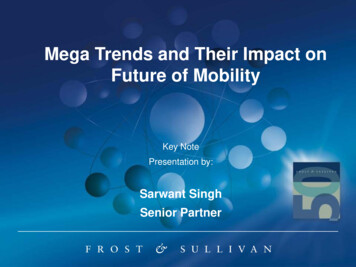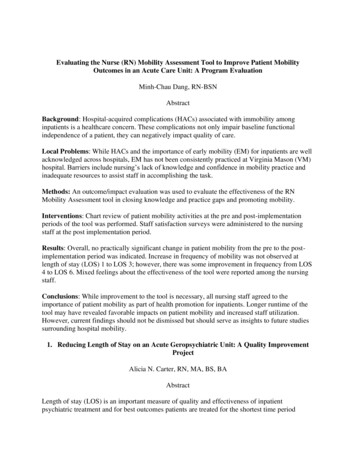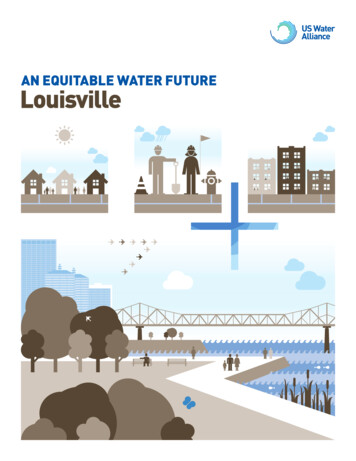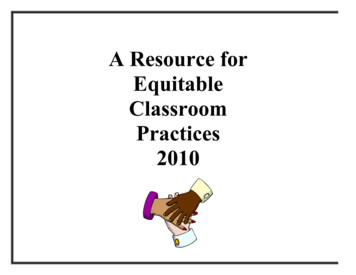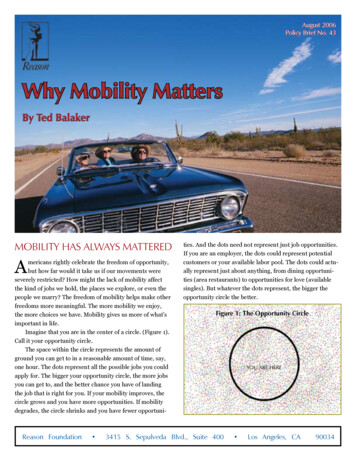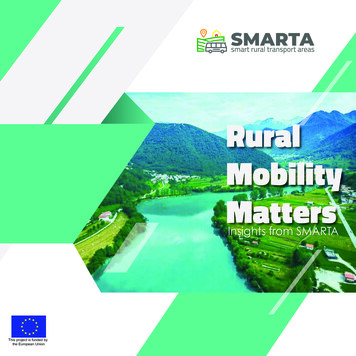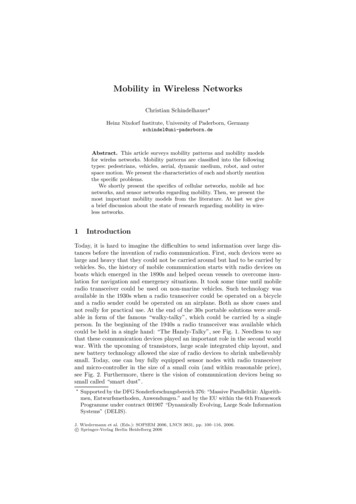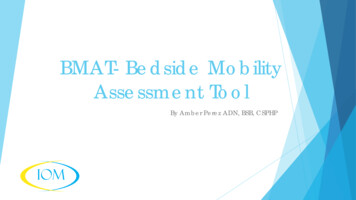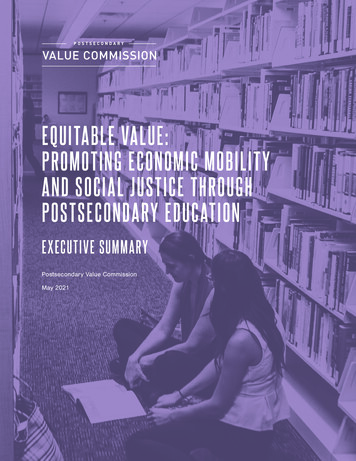
Transcription
EQUITABLE VALUE:PROMOTING ECONOMIC MOBILITYAND SOCIAL JUSTICE THROUGHPOSTSECONDARY EDUCATIONEXECUTIVE SUMMARYPostsecondary Value CommissionMay 2021—1—
TABLE OF CONTENTSForeword. . . . . . . . . . . . . . . . . . . . . . . . . . . . . . . . . . . . . . . . . . . . . . . . . . . . . . . . . . . . . . . . . . . . . . . . . . . 1Acknowledgements . . . . . . . . . . . . . . . . . . . . . . . . . . . . . . . . . . . . . . . . . . . . . . . . . . . . . . . . . . . . . . . . . . 2Members of the Postsecondary Value Commission. . . . . . . . . . . . . . . . . . . . . . . . . . . . . . . . . . . . . . . . . 5Members of the Postsecondary Value Commission Research Task Force. . . . . . . . . . . . . . . . . . . . . . . 6The Postsecondary Value Definition. . . . . . . . . . . . . . . . . . . . . . . . . . . . . . . . . . . . . . . . . . . . . . . . . . . . 10The Postsecondary Value Framework. . . . . . . . . . . . . . . . . . . . . . . . . . . . . . . . . . . . . . . . . . . . . . . . . . . 11Economic Returns for Students. . . . . . . . . . . . . . . . . . . . . . . . . . . . . . . . . . . . . . . . . . . . . . . . . . . . . . . . . 12Economic Returns for Society. . . . . . . . . . . . . . . . . . . . . . . . . . . . . . . . . . . . . . . . . . . . . . . . . . . . . . . . . . 22Non-Economic Returns to Students and Society . . . . . . . . . . . . . . . . . . . . . . . . . . . . . . . . . . . . . . . . . . . 23The Action Agenda for the Postsecondary Value Commission. . . . . . . . . . . . . . . . . . . . . . . . . . . . . . . 25Endnotes. . . . . . . . . . . . . . . . . . . . . . . . . . . . . . . . . . . . . . . . . . . . . . . . . . . . . . . . . . . . . . . . . . . . . . . . . . 26Suggested citation: Postsecondary Value Commission. (2021c). Equitable value: Promoting economic mobility and socialjustice through postsecondary education (executive summary).
FOREWORDSue Desmond-Hellmann, Mildred García, and Mamie VoightFrom the steps of the Lincoln Memorial in 1963, Dr. Martin Luther King, Jr. reminded America of“the fierce urgency of now” when discussing how the United States has defaulted on its “promissorynote . . . that all [people] would be guaranteed the inalienable rights of life, liberty, and the pursuit ofhappiness.”aAnd yet, nearly 60 years later, the insidious ways that racism, classism, and sexism continue to playout in modern-day American society have been laid bare by a national reckoning with pervasiveracial bias and the COVID-19 health crisis. And while both crises have rocked American society toits core, they also have served as a catalyst for many, including our colleges and universities, tocritically reflect on their role in perpetuating or dismantling systemic injustices.Postsecondary education can offer individuals the opportunity to earn a livable wage and build abetter life for themselves and their families, while also fostering a healthier and more democraticsociety. Yet, postsecondary education must do more to dismantle its own inequitable policies andpractices, which play a role in perpetuating and exacerbating the injustices in society at large.It is in this context that the Postsecondary Value Commission has examined how postsecondaryeducation fosters equitable access to critical post-college outcomes, including sufficient earnings,high-quality jobs, and economic mobility and security. Expanding on recent research about howto measure earnings returns, the Postsecondary Value Framework aims to ensure that collegesand universities are serving as engines of mobility, especially for Black, Latinx, Indigenous, andunderrepresented Asian American and Pacific Islander (AAPI) students, students from low-incomebackgrounds, and women.Higher earnings derived from attaining postsecondary credentials operate together with anindividual’s ability to accumulate wealth and reap the benefits from important non-economic returnsto education, such as exposure to new cultures, peoples, and ideas; fostering personal growth;and preparing them to be engaged, equity-minded members of society who are able and willing todisrupt injustices and right past wrongs.As we continue to wrestle with the dual challenges of COVID-19 and longstanding systemic racism,we must embrace the fact that postsecondary value is about both earning a decent wage andbuilding a stronger and fairer democracy. The following pages detail the Postsecondary ValueCommission’s work to capture and operationalize this sentiment. As postsecondary education strivesto meet the urgency of this incredible moment, we see great potential for this work to create a moreequitable and just future.a Yale Law School, Lillian Goldman Law Library. “I have a Dream by Martin Luther King, Jr; August 28, 1963.” The Avalon Project.Retrieved from The Avalon Project website: https://avalon.law.yale.edu/20th century/mlk01.asp—1—
ACKNOWLEDGEMENTSAuthorsThis report was written by Institute for Higher Education Policy (IHEP) and Bill & Melinda GatesFoundation (BMGF) staff, including:Institute for Higher Education PolicyKimberly DancyResearch AssociateKatelyn DiBenedettoResearch AnalystAlyse Gray ParkerResearch AnalystKonrad MugglestoneAssistant Director of Researchand PolicyEleanor Eckerson PetersAssociate Director of Researchand PolicyAmanda Janice RobersonDirector of Research and PolicyMamie VoightInterim President and CEOBill & Melinda Gates FoundationJennifer EngleActing Director, Data,United States ProgramJamey RorisonSenior Program Officer, Data,United States ProgramContributorsWe would like to give special thanks to the following individuals who contributed original research tothis report, participated in countless research and methodological discussions with the BMGF andIHEP teams, and helped push the project’s thinking on measuring postsecondary value:Jordan MatsudairaAssociate Professor of Economicsand Education Policy, TeachersCollege, Columbia UniversityDavid TroutmanChief Data Officer and AssociateVice Chancellor for InstitutionalResearch, The University of TexasSystem—2—
This report represents the culmination of two years of intensive research by a diverse array ofexperts. In particular, we would like to thank the following individuals and organizations whocontributed critical research and analysis:Fenaba AddoAssociate Professor of PublicPolicy, College of Arts andSciences, University of NorthCarolina at Chapel HillGabe A. OronaKayla ElliottInterim Director of Higher Education Ph.D. Student, School of Education,University of California, IrvinePolicy, The Education TrustRichard ArumDean, School of Education,University of California, IrvineMegan L. FasulesFormer Assistant ResearchProfessor and Research Economist,Georgetown University Center onEducation and the WorkforceSarah BarreseFormer Research Associate,Georgetown University Center onEducation and the WorkforceKathryn GimborysSenior Government AffairsAssociate, Institute for HigherEducation PolicyKathryn Peltier CampbellSenior Editor/Writer andPostsecondary Specialist,Georgetown University Center onEducation and the WorkforceJulia GrayResearch Analyst, PostsecondarySuccess, Bill & Melinda GatesFoundationAnthony P. CarnevaleResearch Professor and Director,Georgetown University Center onEducation and the WorkforceBan CheahResearch Professor and SeniorEconomist, Georgetown UniversityCenter on Education and theWorkforceDiane ChengResearch ConsultantMichael CollinsVice President, JFFMarlena CreusereDirector of Advanced Analytics& Business Intelligence, TheUniversity of Texas SystemJacquelynne S. EcclesDistinguished Professor ofEducation and Psychology,School of Education, University ofCalifornia, IrvineArtem GulishSenior Policy Strategist,Georgetown University Center onEducation and the WorkforceMichael C. QuinnSenior Analyst, GeorgetownUniversity Center on Education andthe WorkforceJenna R. SablanFormer Assistant ResearchProfessor, Georgetown UniversityCenter on Education and theWorkforceNicole SmithResearch Professor and ChiefEconomist, Georgetown UniversityCenter on Education and theWorkforceJeff StrohlResearch Professor and Director ofResearch, Georgetown UniversityCenter on Education and theWorkforceJutta HeckhausenProfessor of Psychological Science,School of Social Ecology, University Luise von KeyserlingkPostdoctoral Scholar, School ofof California, IrvineEducation, University of California,Gina JohnsonIrvineSenior Associate, National CenterChristopher M. Wegemerfor Higher Education ManagementPh.D. Student, School of Education,Systems (NCHEMS)University of California, IrvineTiffany JonesCharles E. WrightDeputy Director, PostsecondaryAssociate Professor of CognitiveSuccess, Bill & Melinda GatesScience, School of SocialFoundation (formerly at TheSciences, University of California,Education Trust)IrvineStephanie MarkenKatsumi Yamaguchi-PedrozaExecutive Director of EducationLab Manager, School of Education,Research, GallupUniversity of California, IrvineBen MillerFormer Vice President forPostsecondary Education, Centerfor American Progress—3—
Other AcknowledgementsThis report is the product of hard work from many individuals and organizations. We would liketo thank the BMGF and the IHEP staff who helped in this effort, including Travis Reindl, seniorcommunications officer at BMGF; Jihad D. Dixon, communications associate at IHEP; and PiperHendricks, director of communications and external affairs at IHEP, for their tireless work in movinghundreds of pages through the production pipeline, as well as Janiel Santos, intern at IHEP, for herHerculean efforts in formatting our citations. We would also like to thank Gina Johnson from theNational Center for Higher Education Management Systems for serving as the research projectmanager. And we offer special thanks to Julie Johnson, Rae Ringel, and Brian Tarallo for their effortsdesigning, structuring, facilitating, and graphically recording the Postsecondary Value Commissionmeetings. Their efforts allowed commissioners and the BMGF and IHEP teams to wrestle withchallenging concepts and to draw illuminating insights that informed the commission’s findings.We also thank Deborah Seymour for editing the written products, Jeff Culver for creating visuallyengaging slide decks and graphics, and Anne Fogarty and the team at GMMB for their creativedesign and layout.Finally, we are deeply grateful to the members of the Postsecondary Value Commission andResearch Task Force whose insights and expertise were invaluable in both broadening andsharpening our thinking about postsecondary value. Without their contributions, this project would nothave been possible. We offer special thanks to Sue Desmond-Hellmann, chief strategy advisor andformer CEO of BMGF, and Mildred García, president and CEO of the American Association of StateColleges and Universities, for serving as thought leaders and as the commission’s co-chairs, alongwith Michelle Asha Cooper, who served as the project’s managing partner during her tenure at IHEP.While many experts contributed to this report, the views and opinions expressed here are those ofthe authors and do not necessarily reflect the positions of individual members of the PostsecondaryValue Commission, other individuals acknowledged here, or the organizations they represent. Theauthors also accept responsibility for any errors or omissions.—4—
MEMBERS OF THE POSTSECONDARY VALUE COMMISSIONBrian BridgesSecretary of Higher Education,State of New Jersey*Anthony CarnevaleResearch Professor and Director,Georgetown University Center onEducation and the WorkforceJosé Luis CruzExecutive Vice Chancellor andUniversity Provost, The CityUniversity of New York*Sue Desmond-HellmannChief Strategy Advisor andformer CEO, Bill & Melinda GatesFoundationIvelisse EstradaSenior Vice President, Corporateand Community Empowerment,Univision Communications Inc.(Retired)Nichole Francis ReynoldsVice President/Head of GlobalGovernment Relations at ServiceNow, Inc.*John FriedmanProfessor of Economics,International Affairs, and PublicPolicy, Brown UniversityMildred GarcíaPresident and CEO, AmericanAssociation of State Colleges andUniversitiesPaul GlastrisEditor-in-Chief, The WashingtonMonthlyJillian KleinSenior Vice President ofGovernment and Regulatory Affairs,Strategic Education, Inc.Janice LachanceExecutive Vice President, StrategicLeadership and Global Outreach,American Geophysical UnionLaura PernaVice Provost for Faculty, GSECentennial Presidential Professorof Education, and ExecutiveDirector, Penn AHEAD, University ofPennsylvaniaMark SchneiderDirector, Institute for EducationalSciences, U.S. Department ofEducationTeresa LubbersCommissioner, Indiana CommissionMichele Siqueirosfor Higher Education and Chair,President, Campaign for CollegeGovernor’s Workforce CabinetOpportunityElisabeth MasonFounding Director, Stanford Poverty Zakiya Smith EllisChief Policy Advisor, State of Newand Technology LabJersey*Sean McGarveyPresident, North America’s Building Margaret SpellingsPresident and CEO, Texas 2036Trades UnionsTed MitchellPresident, American Council onEducationLuis TalaveraUndergraduate Student, ArkansasState UniversitySahar MohammadzadehUndergraduate Student, HarvardUniversityIvory ToldsonProfessor of CounselingPsychology, Howard University andPresident and CEO, The QualityEducation for Minorities NetworkMarc H. MorialPresident and CEO, National UrbanLeagueGloria NemerowiczFounder and President, Yes WeMust CoalitionEloy Ortiz OakleyChancellor, California CommunityCollegesAndy Van KleunenChief Executive Officer, NationalSkills CoalitionMamie VoightInterim President and CEO, Institutefor Higher Education PolicyBelle WheelanPresident, Southern Association ofCheryl OldhamColleges and Schools CommissionSenior Vice President, U.S. Chamberon Collegesof Commerce Foundation and VicePresident, Education Policy, U.S.Chamber of Commerce* Several commissioners have changed professional affiliations since the start of the Postsecondary Value Commission.These include Brian Bridges (former vice president of research and member engagement for United Negro CollegeFund, Inc.), José Luis Cruz (former president of the Herbert H. Lehman College, The City University of New York),Nichole Francis Reynolds (former vice president for public policy at Mastercard), and Zakiya Smith Ellis (former NewJersey Secretary of Higher Education).—5—
MEMBERS OF THE POSTSECONDARY VALUE COMMISSIONRESEARCH TASK FORCEFenaba AddoAssociate Professor of PublicPolicy, College of Arts andSciences, University of NorthCarolina at Chapel Hill*Richard ArumDean, School of Education,University of California-IrvinePaul AttewellDistinguished Professor ofSociology and Urban Education,The City University of New YorkGraduate CenterDominique BakerAssistant Professor of EducationPolicy, Annette Caldwell SimmonsSchool of Education andHuman Development, SouthernMethodist UniversityAnthony P. CarnevaleResearch Professor and Director,Georgetown University Center onEducation and the WorkforceColin ChellmanUniversity Dean for Institutionaland Policy Research, The CityUniversity of New YorkDiane ChengResearch ConsultantDebbie CochraneFormer Executive Vice President,The Institute for College Access& SuccessMichael CollinsVice President, JFFMarlena CreusereDirector of Advanced Analyticsand Business Intelligence, TheUniversity of Texas SystemWilliam Darity Jr.Samuel DuBois Cook DistinguishedProfessor of Public Policy, Africanand African American Studies,Economics, and Business &Director of the Samuel DuBoisCook Center on Social Equity,Duke UniversityMesmin DestinAssociate Professor ofPsychology and HumanDevelopment and Social Policy,Northwestern UniversityAmy Ellen Duke-BenfieldSenior Fellow, NationalSkills CoalitionIndivar Dutta-GuptaCo-Executive Director, GeorgetownCenter on Poverty and InequalityDarrick HamiltonHenry Cohen Professor ofEconomics and Urban Policy &Founding Director of the Instituteon Race and Political Economy,The New SchoolTimothy HarmonPresident, Workforce EnterpriseServices, Inc.Kevin JamesFounder and CEO, BetterFuture ForwardGina JohnsonSenior Associate, National Centerfor Higher Education ManagementSystems (NCHEMS)Tiffany JonesDeputy Director, PostsecondarySuccess, Bill & Melinda GatesFoundation*Kayla C. ElliottInterim Director of Higher EducationRobert KelchenPolicy, The Education TrustAssociate Professor of HigherEducation and Chair, Department ofLorelle EspinosaEducation Leadership ManagementProgram Director, Alfred P. Sloanand Policy, Seton Hall UniversityFoundation*Antoinette FloresManaging Director forPostsecondary Education,Center for American ProgressStella FloresAssociate Professor of HigherEducation & Director of Accessand Equity, The Steinhardt Institutefor Higher Education Policy,New York UniversityJohn FriedmanProfessor of Economics,International Affairs, and PublicPolicy, Brown University—6—Jorge Klor de AlvaPresident, Nexus Researchand Policy CenterStephanie MarkenExecutive Director of EducationResearch, GallupJordan MatsudairaAssociate Professor of Economicsand Education Policy, TeachersCollege, Columbia UniversityBen MillerFormer Vice President forPostsecondary Education,Center for American Progress
Robert J. MorseChief Data Strategist, U.S.News & World ReportAndre M. PerrySenior Fellow, Metropolitan PolicyProgram, Brookings InstitutionLaura PernaVice Provost for Faculty, GSECentennial Presidential Professorof Education, and ExecutiveDirector, Penn AHEAD, Universityof PennsylvaniaNicole SmithResearch Professor andChief Economist, GeorgetownUniversity Center on Educationand the WorkforceJeff StrohlResearch Professor andDirector of Research, GeorgetownUniversity Center on Educationand the WorkforceDavid TroutmanChief Data Officer and AssociateVice Chancellor for InstitutionalResearch, The University ofTexas System* Several RTF members have changed professional affiliations since the start of the Postsecondary Value Commission.These include Fenaba Addo (former associate professor at the University of Wisconsin-Madison), Lorelle Espinosa(former vice president for research at the American Council on Education), and Tiffany Jones (former senior directorof higher education policy at The Education Trust).—7—
While structural racism has been part of the United States since before its founding, continued racialand gender violence alongside the coronavirus pandemic have exacerbated racial inequities acrossthe country. The disproportionate impact of these events on people of color has catalyzed nationwideactivism leading to renewed conversations about who has true access to opportunity in this country.1Against this backdrop, the Postsecondary Value Commission (Sidebox 1) leveraged diverse voicesand experiences to interrogate the role that postsecondary education can—and should—play inpromoting opportunity, paving an equitable path to economic mobility, and dismantling centuriesof racist, classist, and sexist attitudes and policies. To be clear: overall, postsecondary educationoffers individuals the opportunity to earn a better living and build a better life for themselves and theirfamilies, while also fostering a healthier, more democratic society. Yet, troubling disparities in accessto these opportunities exist by race, ethnicity, socioeconomic status, and gender.Sidebox 1. Who Comprised the Postsecondary ValueCommission?The Bill & Melinda Gates Foundation (BMGF) launched the Postsecondary Value Commission in April2019, with the Institute for Higher Education Policy (IHEP) managing the project.a The commission, cochaired by Sue Desmond-Hellmann and Mildred García,b is comprised of 30 members, representingeducators, executives, policymakers, researchers, advocates, and students. Their broad and diverseexperiences helped the project explore ways to define and measure equitable postsecondary valueand build momentum toward actionable change. To inform this work, BMGF and IHEP convened thePostsecondary Value Commission Research Task Force (RTF), comprised of expert senior researcherswho helped the commission understand the philosophical, measurement, and policy considerations andassumptions underlying components of postsecondary value.Postsecondary education can do more to promote economic and social mobility.Postsecondary institutions have the power to create opportunities for economic and social mobilityfor all students—but especially Black, Latinx, Indigenous, underrepresented Asian American andPacific Islander (AAPI) students, students from low-income backgrounds, and women. Studentswho complete credentials typically are more likely to be employed, earn higher wages, have greateraccess to retirement and healthcare plans, have better physical health, and engage in more civicminded behaviors when compared with those who did not complete a credential.2However, these life-altering credentials and their associated returns are not distributed equitably.3Low completion rates,4 high prices,5 racial/ethnic and socioeconomic stratification across and withininstitutionsc and by field of study,6 and inequitable debt loads7 contribute to an increasing numberof students of color and students of all genders and races/ethnicities from low-income backgroundsbeing left behind. In the most troubling cases, students leave college with debt but no degree, whichrenders individuals worse off than if they had not gone to college at all8 and contributes to persistenta Michelle Asha Cooper, IHEP’s former president, served as the managing partner from April 2019 to January 2021. IHEP’s interimpresident and CEO Mamie Voight is currently serving as the managing partner.b Sue Desmond-Hellmann is the chief strategy advisor and former CEO of the Bill & Melinda Gates Foundation, and Mildred García isthe president and CEO of the American Association of State Colleges and Universities (AASCU).c See Tables 1.1 and A1 in: Postsecondary Value Commission. (2021a). Equitable value: Promoting economic mobility and socialjustice through postsecondary education. Retrieved /uploads/2021/05/PVC-Final-Report-FINAL.pdf—8—
societal wage and wealth gaps.9 Such inequities also lead to substantial lost economic potentialin the form of tax revenues, Gross Domestic Product (GDP), and spending on public health, publicassistance, and criminal justice.10But it doesn’t have to be this way. The Postsecondary Value Commission’s work offers threeequity-centered tools to identify, measure, and address inequities in access, completion, and postcollege outcomes:1. A definition of postsecondary value—guided by fivecore principles—is the foundation upon which theframework and action agenda are built, and a field-ledmovement to increase equitable value can flourish.2. Expanding upon the definition and core principles, thePostsecondary Value Framework outlines the clearvalue-add that postsecondary education can provideto students and society, in both economic and noneconomic terms. The centerpiece of this framework is aseries of economic value thresholds that measure postcollege earnings and wealth inequities.Together, the valuedefinition, framework,and action agenda aredesigned to catalyzean equitable valuemovement, which willhelp reshape the highereducation system inthe United States bycombating access andcompletion barriers,sparking economicmobility, dismantlingracist practices andstructural inequalities,and building a morevibrant and just society.3. Finally, the action agenda outlines policies andpractices that institutional leaders and federal and statepolicymakers should implement to address systemicbarriers that prevent Black, Latinx, Indigenous, andAAPI students, students from low-income backgrounds,and women from reaping equitable returns frompostsecondary education and achieving economicand social mobility. The agenda also includes criticalquestions for which students and families shouldexpect institutions to answer as they determine whichinstitutions and programs can provide them with the most value.Together, the value definition, framework, and action agenda are designed to catalyze an equitablevalue movement, which will help reshape the higher education system in the United States bycombating access and completion barriers, sparking economic mobility, dismantling racist practicesand structural inequalities, and building a more vibrant and just society.dd The Postsecondary Value Commission’s definition of justice—in which one’s background does not predict life outcomes—is basedon input from commissioners and Research Task Force members. Commissioners expressed a deep interest in leveraging theproject’s work to promote equity, freedom, and justice for students in the postsecondary context. To further the Postsecondary ValueCommission’s understanding of the role institutions can play in advancing justice, four members of the RTF authored papers on whata just society would look like: Baker (Forthcoming); Flores (Forthcoming); Perry (Forthcoming); and Jones (Forthcoming). Commonthemes in their papers shaped the commission’s definition of justice.—9—
THE POSTSECONDARY VALUE DEFINITIONThe commission’s value definition offers a goal grounded in equity for guiding the collective workof institutions and policymakers to improve student outcomes. An accompanying set of five coreprinciples provides guidance on how the field should interpret and use the definition (Figure 1).Figure 1. Conceptual Definition and Core PrinciplesStudents experience postsecondary value when provided equitable access and support tocomplete quality, affordable credentials that offer economic mobility and prepare them toadvance racial and economic justice in our society.Equity matters.In a country where college is crucial to economic and social mobility, it is not acceptablethat some students—especially Black, Latinx, Indigenous, and Asian American and PacificIslander (AAPI) students, students from low-income backgrounds, and women—facesystemic barriers as costs continue to grow, completion rates remain low, and wageinequities persist that prevent them from realizing the full value of postsecondary education.Institutions andprograms matter.While there is overwhelming evidence that a college education is indeed “worth it,”institutional leaders, faculty, and staff must deliver a quality education by intentionallyconstructing valuable learning experiences and career pathways with employers to ensure allstudents develop the knowledge, skills, and networks needed to be successful in work andlife, including the ability to navigate and influence society to promote equity and justice.Policy matters.To remove systemic barriers to equitable postsecondary value, federal and statepolicymakers should work with institutional leaders to develop funding, financial aid, andaccountability mechanisms that incentivize creating coherent P-12, postsecondary, andworkforce pathways and improving educational experiences and outcomes for Black,Latinx, Indigenous, and Asian American and Pacific Islanders (AAPI) students, studentsfrom low-income backgrounds, and women.Public returns—andinvestment—matter.While equitable postsecondary value yields clear returns for students and families, publicinvestment in closing racial and socioeconomic attainment gaps also benefits the broadersociety through increases in tax revenues and GDP, decreases in public health and otherexpenditures, and increases in voting, volunteerism, and civic participation, which builds amore just society.Measuring valuematters.Collecting and using the necessary data to understand whether and how institutionsand programs deliver value to Black, Latinx, Indigenous, and Asian American andPacific Islander (AAPI) students, students from low-income backgrounds, and women, incomparison to their peers, is critical because the nation can no longer afford to ignoreinequities in the system if we are to fulfill the promise of postsecondary education tostudents and society.— 10 —
THE POSTSECONDARY VALUE FRAMEWORKEquitable postsecondary value is comprised of many interconnected elements. Institution leaders,federal and state policymakers, and other stakeholders all have a role to play in delivering equitablevalue, the economic and non-economic benefits of which accrue to students, their families, theircommunities, and society. The commission relied on a wide body of research—some conductedprior to the project, and much of it led by Research Task Force (RTF) members—to construct aframework for understanding these many components on their own and as they relate to one anotherto conceptualize postsecondary value (Figure 2).PostsecondaryValue FrameworkFigure2. The PostsecondaryValue FrameworkPipeline to Equitable ValueFor Black, Latinx, Indigenous, and AAPIstudents, students from low-incomeStudent SocialJustice Agencybackgrounds, and women—and theintersectional identities within andacross these groupsStudentLearningOutcomes& ent,& PluralismEconomic& CulturalVitality inCommunitiesWorkforceDiversity & PayEquityPublicRevenues &Gross DomesticProductInstitutional leaders, federal and statepolicymakers, and other stakeholders deliver:PublicHealthValue for StudentsValue for SocietyBy equitably promotingtheir economic mobility,ensuring opportunity tobuild wealth, and improvingindividuals’ wellbeing andacademic, civic, and
Commission's work to capture and operationalize this sentiment. As postsecondary education strives to meet the urgency of this incredible moment, we see great potential for this work to create a more equitable and just future. a Yale Law School, Lillian Goldman Law Library. "I have a Dream by Martin Luther King, Jr; August 28, 1963."
